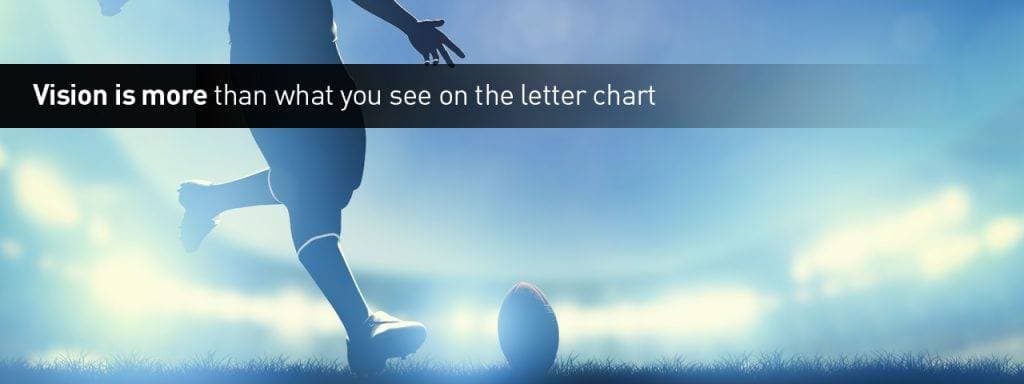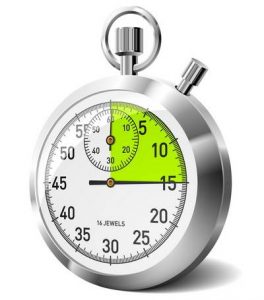Do you feel like your sports performance does not measure up to your athletic ability?
You may be suffering from a vision problem— read on to find out more.
Sports and vision
Vision is not only about how well you can see, it also involves 17 different visual skills that enable accurate, smooth, and precise eye movements for clear and comfortable vision— all necessary for many daily activities. These visual skills allow you to visualize, use your peripheral vision, switch visual focus between target points at varying distances, sustain focus on a moving target, and more!
The 17 visual skills are essential for success in reading, writing, and sports performance. Reduced performance in any of these areas may indicate a problem with the visual skills.
In other words, a vision problem may actually be causing the difficulty you are experiencing while participating in sports activities.
Common signs that a vision problem is impacting your sports performance:
- Aversion to team sports
- Diminished interest in sports
- Difficulty catching or throwing
- Inability to see the ball clearly
- Struggling to track the ball or other players
- Over or under estimating distances
- Poor sports performance even with strong athletic skills
- Improvement is not noticed even with practice
- Trouble remembering plays
If you want to improve your sports performance, contact an eye doctor near you, who can discuss how to take your game to the next level.
SEE RELATED: Vision for Baseball
Visual skills necessary for sports performance
Sports activities require accuracy and speed for optimal performance. These skills allow you to track a ball as it flies through the air, stand in the correct location to catch a ball, and accurately pass the ball to another player.
Reduced visual skills will make it difficult to participate in sports activities and team sports— and may even lead to a poor self-image or self-esteem.
The following skills are essential for optimal sports performance:
1 Dynamic visual acuity
Dynamic visual acuity allows you to see moving objects clearly. This skill is essential for sports such as tennis, racquetball, hockey, or soccer for the ability to clearly see the ball and other players while you and/or the other objects are moving quickly.
2 Eye tracking
Eye tracking allows you to keep your eyes on the ball at all times, without moving your head— enabling the ability to maintain better balance and a faster response to the situation. This skill is essential for any fast moving sport, or any type of game played with a ball.
3 Eye focusing
Eye focusing allows you to change focus quickly and accurately between two distances (near and far). This skill is essential for playing all types of sports that involve looking at the goal in the distance, while managing and moving around the opponents up-close.
4 Peripheral vision
Peripheral vision allows you to see images and objects such as a teammate or opponent, “out of the corner of your eye” while fixating on a target. This skill is essential for all sports, for the ability to see what is going on all around you without having to turn your head.
5 Depth perception
Depth perception allows you to quickly and accurately judge the speed and distance of objects. This skill is essential for estimating the location of the ball, teammates, opponents, boundary lines, goals, and other objects.
6 Visual reaction time
Visual reaction time allows you to interpret and react to your teammate’s or opponent’s action, in an appropriately timed manner. This skill is essential for swinging a bat, catching a ball, or returning a tennis serve.
7 Eye-hand coordination
Eye-hand coordination allows you to react to incoming visual information with accurate body movements. This skill is essential for sports because it enables accurate timing and control over body movements, such as when swinging a bat, taking a shot, and shooting hoops.
8 Visual memory
Visual memory allows you to interpret and remember a fast-moving, multi-detailed image, including both people and objects. This skill is essential for sports, specifically for “being in the right place, at the right time”— enabling you to remember the location of your teammates and opponents as you try to remain in control of the ball.
9 Visualization
Visualization allows you to imagine yourself succeeding, while at the same time concentrating on something else. This skill is essential for sports as it enables you to visualize yourself shooting the ball into the hoop, or hitting the perfect serve, while concentrating on the ball— imagining the success of your action facilitates the actual success. According to research, the areas of the brain that light up during performance, also light up when a person visualizes the performance.
10 Visual concentration
Visual concentration allows you to maintain focus on an object or target, with the presence of distracting factors in your field of vision. This skill is essential for sports, specifically in situations when spectators are reacting or cheering around you, if an object is thrown on the court, or the timer on the scoreboard is approaching the end of the period.
Can vision therapy improve visual skills for sports?
Yes.
Most binocular vision conditions are caused by problems within the eye-brain connections, or the way that the brain processes the visual information coming in through the eyes— also known as visual processing. If a vision problem is detected, a program of vision therapy will help to retrain your visual system, to improve your vision skills.
Vision therapy can be defined as the science of achieving clear and comfortable vision.
Vision therapy is a fully customized treatment program designed to improve and strengthen the visual skills, and re-train the eye-brain connections to interpret visual input with increased accuracy and ease.
The aim of vision therapy is to enhance the visual skills— eye-tracking, focusing, eye-hand coordination, peripheral vision, visual processing speed and more!
Vision therapy is conducted once per week in your eye doctor’s office, with each session lasting 30-45 minutes. Each program is designed for the specific needs of each patient, and involves a variety of eye exercises and activities to strengthen the visual skills. In addition to in-office sessions, homework is given to reinforce what the skills learned during each session.
Ever heard of Larry Fitzgerald?
Larry Fitzgerald Jr. is a famous NFL wide receiver for the Arizona Cardinals. He played college football at Pittsburgh, where he earned uncontested All-America honors. He was drafted by the Cardinals third overall in the 2004 NFL Draft.
Here are just some of Larry Fitzgerald’s sporting achievements:
- Selected for the Pro Bowl eleven times, he was named First-team All-Pro in 2008 and Second-team All-Pro twice in 2009 and 2011.
- Fitzgerald and Hall of Famer Jerry Rice are the only wide receivers in NFL history to be selected for the Pro Bowl at least 11 times.
- His 234 games played are tied with K Jim Bakken (1962-78) for the most in franchise history.
- Named a co-winner of the 2016 Walter Payton NFL Man of the Year award— the only league award that recognizes a player’s community services as well as his playing achievements.
- Franchise career leader in receptions (1,303), receiving yards (16,279), receiving TDs (116), total TDs (116), 100-yard receiving games (47) and consecutive games with a reception (227).
- Ranked second in NFL history in career receiving yards (16,279), third in receptions (1,303) and is tied for sixth in NFL history with 116 career TD receptions.
Larry Fitzgerald, has been advocating vision therapy for years.
As a young child, Mr. Fitzgerald struggled with academic difficulties. Fortunately, his grandfather, Robert Johnson, the founder of an optometry clinic in Chicago, understood the important role the visual skills play in reading, writing, and sports activities.
Mr. Fitzgerald underwent a program of vision therapy to strengthen the skills he needed to succeed in school. By the time he turned 12 years old, Mr. Fitzgerald began to take interest in sports, and required further strengthening of visual skills directly related to his sports performance. In turn, Dr. Johnson began to tailor his grandson’s vision therapy exercises to facilitate his success on the field.
Through vision therapy, Mr. Fitzgerald improved his visual dominance, control, precision, spatial judgment and rhythm. Mr. Fitzgerald is a firm believer that his visual training helped him to be successful on the football field. As Mr. Fitzgerald says, “When you’re at that age, anything that helps strengthen your eyes and eye-hand coordination is going to definitely help with catching the ball”.
LEARN MORE: Guide to Sports Vision
Schedule a comprehensive vision evaluation with your eye doctor to assess the integrity of your visual skills, and to determine if vision therapy will help to enhance your sports performance.
If you want to improve your game, sports vision training may be what you have been searching for.









